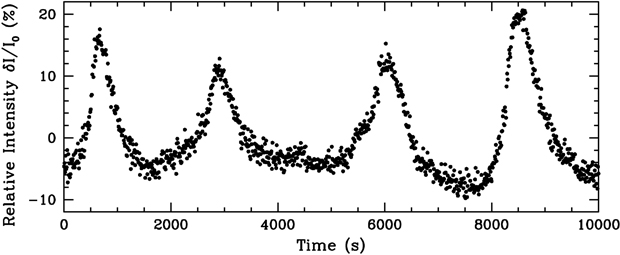
A 2.8-hour (10,000-second) snapshot of high-amplitude luminosity variations caused by pulsations in the low-mass white dwarf J1518+0658.
|
Pulsations in White Dwarfs
When we observe a white dwarf in space, it is true that we are seeing it as it was tens or hundreds of years ago, since it took light that long to reach our eyes here on Earth. It is also true that we are only seeing light from a thin layer right at the surface, since the photons will have scattered many times off the deeper material before they can escape.
In some ways this makes our understanding of the composition and internal constituency of stars superficial. However, just as we can explore the interior of the Earth using seismology, the propagation of waves from earthquakes, we can unravel the inner secrets of stars using stellar pulsations, global stellar oscillations that respond differently depending on the internal composition of these objects. This affords us a unique window into the inside of stars otherwise inaccessible.
Fortunately, white dwarf stars have been known to pulsate for more than 45 years, and the theory behind their pulsations is relatively well understood. Due to their strong surface gravities, white dwarfs generally have highly stratified atmospheres, differentiated by lighter elements that rise to the top and heavier elements that sink down below. We focus here on the subset of white dwarfs with only a thin veil of hydrogen at their surface, belonging to the spectral class DA.
Since they are essentially the bared cores of stars, typical white dwarfs begin their lives with very high temperatures. If the surface temperature of a white dwarf exceeds roughly 12,500 K, the hydrogen at the surface of such a hot star is completely ionized --- the negatively charged electrons move too quickly to be bound to the positively charged protons, and the atoms at the surface are in an ionized state. Light escaping from the interior of the star passes easily through these ions and free electrons.
However, white dwarfs evolve by cooling, and as the surface reaches lower temperatures these hydrogen atoms can begin to recombine (the electrons can begin to rejoin and orbit the protons). These atoms with now-bound electrons form a partial-ionization zone and can begin to effectively absorb radiation leaving the center of the white dwarf. This partial-ionization zone can now efficiently store and release large amounts of energy, which provides the sufficient conditions to drive global pulsations. Such a pulsating white dwarf is now located inside the so-called DAV (or ZZ Ceti) instability strip, and the global pulsations are manifest as periodic brightness changes, caused by temperature changes on the surface of the star that keep a regular tune. These are the stars a-singing.
We can then match the notes from these pulsating stars to detailed models in order to infer the interior properties of these stars. This is similar to how the app Shazam identifies a song on the radio; a computer algorithm Fourier transforms the music, which determines the dominant frequencies in the song, which the app then matches to a database of processed songs to make an identification. For white dwarf stars we are instead using the periods of gravity-mode (g-mode) pulsations that have been excited, the periods of which we match to detailed theoretical models.
|